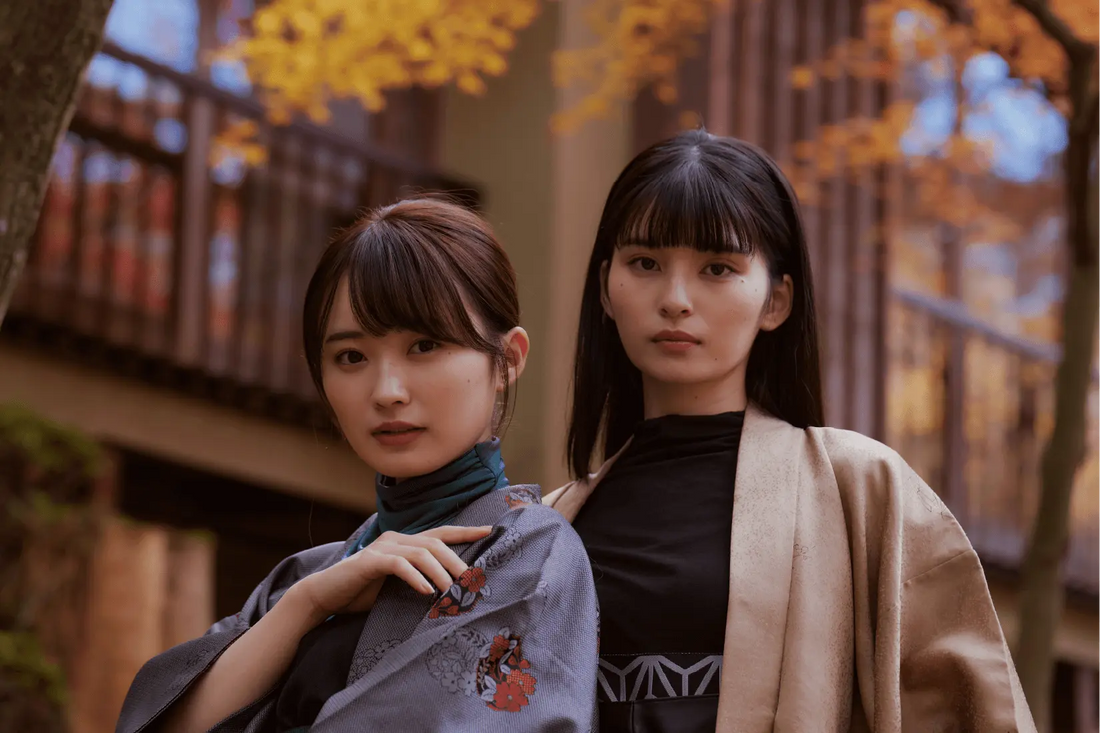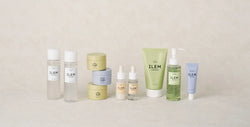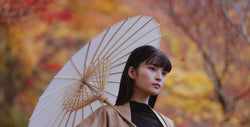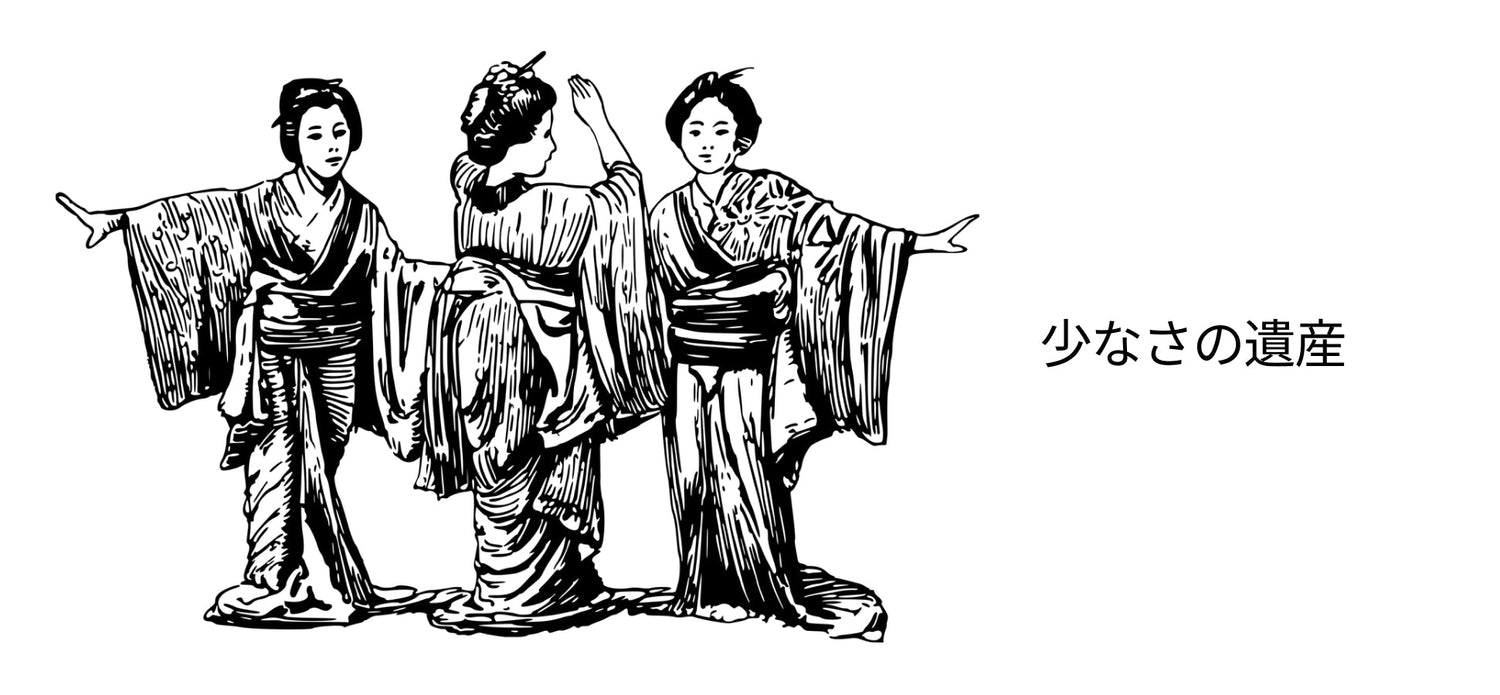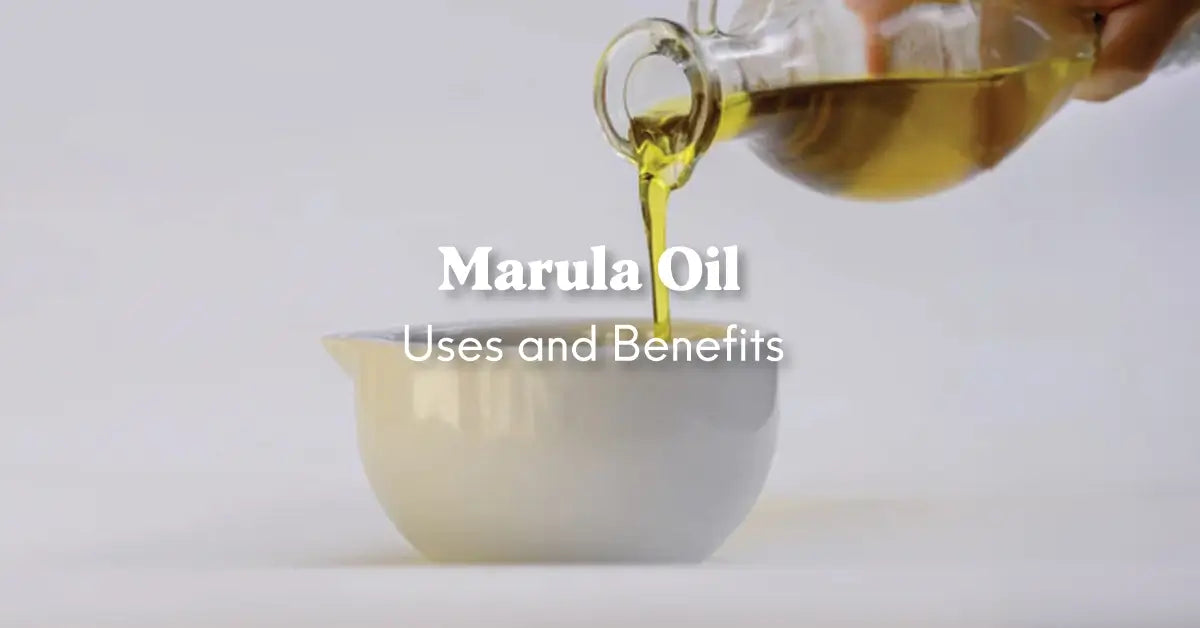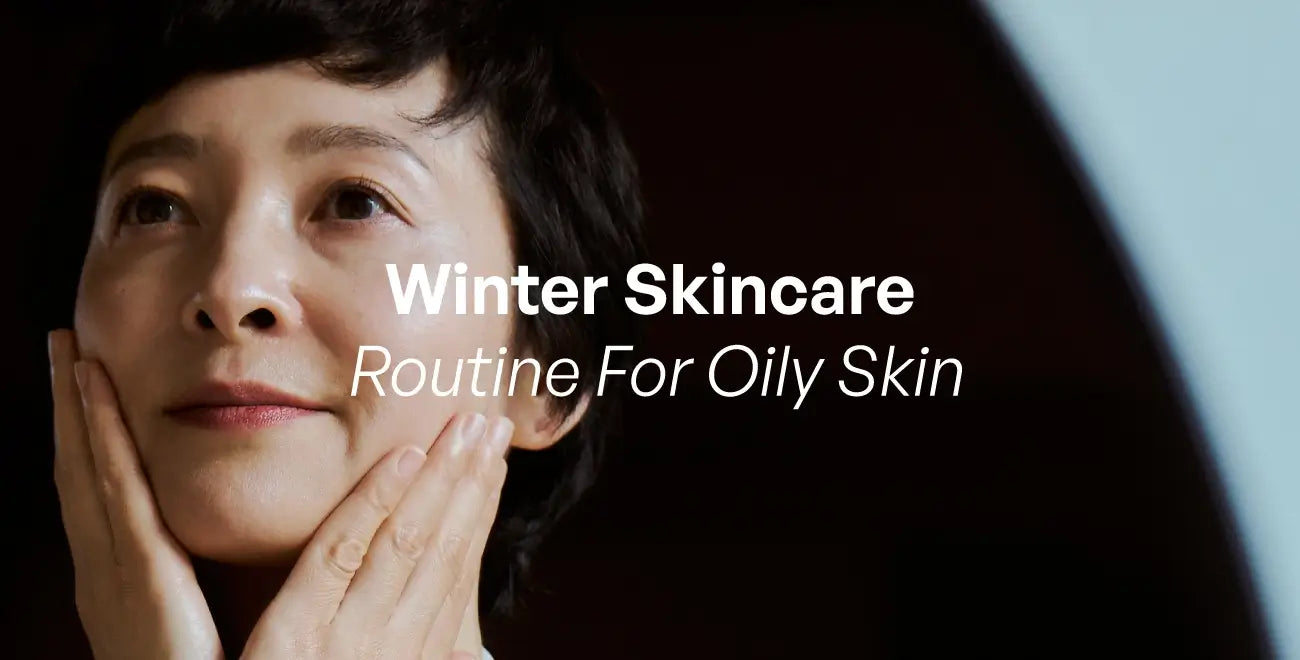J Beauty vs. K Beauty: Exploring the Differences and Similarities
When it comes to skincare, J-beauty and K-beauty don’t mess around. They are always one step ahead, whether it's about the ingredients each uses or the philosophies.
Skincare is more than just fancy packaging and catchy marketing slogans for them. It's a way of life. As a result, both Korean and Japanese skincare and beauty routines are nothing short of rituals. They’re steeped in tradition and backed by cutting-edge innovation to uncover the radiant complexion.

We are not here to join the 2018 debate “J-beauty vs. K-beauty: Which one is better?.” But rather to understand the two on a deeper level. And so today, we will peel back the layers of these globally acknowledged beauty routines to understand two things:
- What sets these beauty philosophies apart?
- What unites them under the vast umbrella of Eastern skincare wisdom?
And while we are at it, we have some amazing skincare suggestions for you. These products are crafted from natural ingredients to shower your skin with all of nature’s goodness! Who knows, you may end up finding your newest love!
Core Principles of J-Beauty
J-beauty, as a whole, is founded on the notion of minimalist routine. It incorporates some of nature’s finest ingredients in a simple routine. Moreover, the routine focuses on two things:
- Care and solution for the present skin issues
- Prevention of future issues
Therefore, it takes a proactive and preventive approach to skin care. It also realizes that every individual’s skin has unique needs. Thus, it focuses on personalized routines for long-term skincare benefits. Finally, J-beauty routines are focused on achieving mochi skin. Mochi skin refers to plump, hydrated, clear skin with a matte, velvety finish. It has a shine-free radiance.
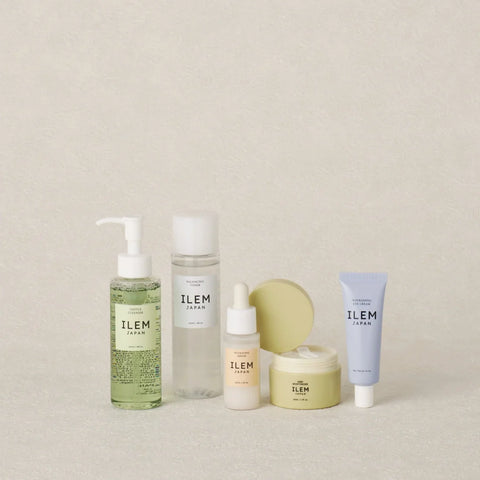
Some iconic Japanese skincare ingredients include the following:
- Marula Oil for intense hydration and nourishment, as found in our Hydrating serum.
- Squalane to tone, hydrate, and plump your skin, like our squalane-infused Purifying Cleanser.
- Japanese Sakura extract, found in our Clarifying Toner, to soothe your skin. It also reduces redness and fades dark spots for a radiant complexion.
- Sake for gentle exfoliation and skin softening. Our mild cleanser infused with Sake helps you achieve brighter, softer, and plump skin.
- Shea butter for softening your skin, preventing cell damage, and sealing moisture. ILEM JAPAN’s Deep Moisturizer with Shea butter revives your dry skin, making it velvety soft.
Core Principles of K Beauty
At the core of K-beauty is an emphasis on gentle nurturing for healthy-looking skin in the long term. They, too, like J-beauty, focus on personalized routines. But here’s the difference.
Unlike J-beauty, a K-beauty routine is extensive. Think of the 10-step or the 12-step skincare routine. Moreover, K-beauty routines are innovative and experimental. For instance, the use of ampoules with microneedles of marine solids, essences, and ingredients like snail mucin.
Another difference is in the goal of the skin texture. K-beauty focuses on glass-skin texture, unlike matte, velvety mochi skin. Glass skin refers to a kind of wet, flawless, and dewy skin. Some of the popular ingredients you will find in Korean skincare include the following:
- Snail mucin
- Propolis
- Pearl
- Yuza
- Bamboo
- Royal Honey
- Birch
- Cactus
Skincare Routines: J Beauty vs K beauty
One of the main differences between the two beauty routines is their elaborateness. While J-beauty is minimalist-driven, K-beauty proudly indulges in a multi-step routine. Here’s a detailed breakdown of the two:
J-beauty's Minimalist Routine
A J-beauty skincare routine typically consists of 4 important steps and focuses on minimalism. And that’s the beauty of it. It works its magic with fewer products, delivering just the same results as more elaborate routines. This means your skin receives all the necessary nourishment with few chemicals. Less harm, more good!
Additionally, their morning routine differs from the night routine, considering environmental factors. This makes it even more impactful! Now, let’s take a closer look.
AM Skincare Routine
#1 Cleanse
Unlike other routines, J-beauty cleansing is effortless. All you need to do is splash some cold water on your face. Yes, that’s it. It does not require you to use a proper cleanser. This is because it focuses on awakening your skin without stripping off its natural oil.

And in case you need to use a cleanser, opt for a gentle hydrating cleanser. It serves a dual purpose in the sense that it:
- Gently removes all dirt and oil that may have accumulated overnight
- Gives your skin a boost of hydration for a hydrated, plumpy look.
The best thing about the Japanese skincare routine is its focus on hydration. You will notice how every step includes hydration to help your skin maintain its glow.
#2 Toner
Next, use a toner (or a lotion, as they call it) to soothe your skin and restore its pH. The Japanese use alcohol-free toners to improve hydration and tighten the pores.

These toners are gentler on the skin and act to ‘prime’ your skin with quick hydration to improve the absorption of the following products. Furthermore, they effectively retain your skin’s natural oil, a natural moisturizer. Plus, they’re super lightweight and leave behind no greasiness. Win-win for all!
#3 Serum
Serums are used as part of layering for intense hydration. They work to target particular issues like dark spots or uneven skin tone.

Japanese serums stand out for their unique blend of ingredients. You will often find botanical ingredients like Green Tea or Rice Bran combined with super-hydrating ingredients like Hyaluronic acid or actives like Retinoids. Their fast-absorbing formula makes them best for those with a busy lifestyle.
#4 Moisturize
J-beauty loves hydration, and moisturizers offer just that. Moisturized skin is often viewed as a sign of good health. Well-moisturized skin appears supple, radiant, and youthful, meeting the Japanese goal of “mochi” skin.
The Japanese skincare routine also places great emphasis on anti-aging. Moisture retention in the skin plays a vital role in reducing the appearance of fine lines and wrinkles. Furthermore, they believe in enhancing the skin’s natural beauty rather than relying on makeup. Moisturized skin provides a healthy, natural glow that doesn't require heavy makeup.
Japanese beauty also views moisturization as a critical way to prevent skin issues like eczema, dermatitis, and acne. If you think about it, Japanese skincare takes a holistic approach and attempts to avoid skin problems from the root. This is what makes it simple yet effective.

When it comes to choosing the right moisturizer for you, it all boils down to the weather and skin type. You can use a light moisturizer for dry and humid weather and a thick moisturizer in winter to nourish your skin.
As for your skin type, it is advisable to opt for a light moisturizer if you have a combination of acne skin type. If you have a dry skin type, then a thick moisturizer will be better suited.
#5 SPF
Finally, layer your sunscreen. A J-beauty routine is incomplete without sunscreen application, given the awareness of sun-induced skin damage. For this, you can opt for a physical or chemical sunscreen. Whatever you choose, be sure it has the highest SPF and PA rating.
PM Skincare Routine
J-beauty's PM skincare routine is more intensive than the morning one. Wondering why? It’s because your skin goes through a lot during the day–pollution, stress, excessive oiliness, dirt, and more. Thus, it needs to be pampered and nourished with nature’s finest. Here’s how!
#1 Double cleansing
Did you know that the double cleansing method is believed to have originated in Japan? You read it right! Double cleansing has been a fundamental part of the Japanese skincare routine with historical roots.
Back then, double cleansing was the only method to remove white metallic paint worn by women. First, they would use an oil-based cleanser to wash off the paint-like foundation and a foam cleanser to remove all residue. Thus leaving the skin clean and refreshed.
Unlike the AM skincare routine, the PM skincare routine requires double cleansing. The goal is to remove all makeup and dirt your skin has been exposed to during the day. For this, you first go in with an oil-based cleanser and follow it with a foaming cleanser.
There’s also a particular way to use these two cleansers. Work the oil-based cleanser from the sides of your face to the T-zone. And do the opposite with a foam cleanser. This particular step is a part of their traditional “oshiroi” or the “white face” routine.
Ultimately, what sets Japanese cleansers apart from the rest is their texture. They are typically gentle and hydrating to avoid damage to your skin’s protective barrier.
#2 Layer Hydration
As you know, the Japanese are big on hydration. So, like the AM routine, you must layer hydrating products in your PM skincare routine. This includes the toner, serum, and moisturizer.

Pro tip: If you feel like your skin needs extra hydration, you may go ahead and apply a thick moisturizer. Overnight, it will work to repair your skin and nourish it.
#3 Eye Care
Your under-eye is among the first areas to show early signs of aging. Also, it is more prone to damage since it is extremely thin and delicate. Thus, the P.M. routine focuses primarily on eye care for repair and rejuvenation.

Take a pea-sized amount of under-eye cream on your ring finger for proper application. You can either tap it into the skin or massage it.
Extra Care
Exfoliation
Exfoliation is the key to glowing skin in Japan and everywhere else. Over time, dead skin cells accumulate on the surface, dulling your face. The Japanese thus exfoliate once or twice a week after double cleansing to remove dead skin cells. Besides this, it improves the absorption of other products, increasing their effectiveness.
Again, they do it a little differently. Skin health is at the heart of every step in a J-beauty routine. So, like other steps, they believe in taking a gentler approach to exfoliation. This is to avoid:
- Damaging the skin’s protective barrier
- Irritating the skin
- Excessive drying of the skin
Sheet Masks
Who does not love a good, relaxing sheet mask that melts away the day’s stress and gives them a spa-like experience at home? We all do, right?
Sheet masks complement the use of serums in your routine, increasing their efficacy. And mind you, J-beauty takes sheet masks very seriously. And the mere variety of sheet masks, from All-in-one to Kabuki face masks, proves this. Moreover, the sheet masks are available in a variety of materials. For instance, cotton, hydrogel, and biocellulose material.

These sheet masks offer a quick boost to your skin and help target specific concerns. For instance, aging, hyperpigmentation, and parched skin. What makes them unique is the use of time-tested ingredients suitable for all skin types.
To make the most of your sheet mask, apply it after a toner. Let it sit for some time, then massage the leftover essence into your skin. And while you’re doing it, don’t forget to apply it to your neck!
K-beauty’s Multi-Step Routine
K-beauty skincare routine is comparatively longer with several products. Furthermore, it takes an experimental approach to the kind of ingredients it uses. Here’s a quick breakdown of the steps:
Cleansing oil
Start by using an oil cleanser to remove makeup, excess oil, pollution, and any dirt on the skin.
Water-based cleanser
Next, use a water-based cleanser and massage it in circular motions. This helps to remove any sweat and leftover dirt. Then rinse with lukewarm water and pat dry.
Exfoliate
Use a physical or chemical exfoliator to clean pores. It also removes any dead skin buildup and helps other products absorb better into the skin. The routine often asks you to do it once every day, preferably at night.
Toner
Like J-beauty, K-beauty toners are also hydrating. They use them to prep their skin for the next steps. It removes leftover residue from the cleanser and balances your skin’s pH. All you need to do is take some toner on a cotton pad and swipe it across your face. You may also choose to pat it using your hands.
Essence
They are lightweight and aimed at hydrating and complexion enhancement. You sprinkle it into your hands and gently pat it in to apply.
Treatment
This step includes boosters, serums, and ampoules. While serums are a part of J-beauty, boosters and ampoules differentiate K-beauty. A Korean skin booster falls somewhere between a toner and a serum. You can use them right after cleansing or layer on before serums, ampoules, and moisturizers.
An ampoule, on the other hand, is more concentrated than serum. Think of a small capsule or a tube with the highest concentration of active ingredients. They are great for tackling skin concerns that your skincare routine otherwise cannot overcome. But there’s also a downside.
Some ampoules are specially designed for use after in-clinic treatments. If one is unaware of this, they may irritate their skin, doing more harm than good. Furthermore, ampoules are highly concentrated products. As a result, those with sensitive skin types may need consultation with a dermatologist. Moreover, they are not designed to be a part of your regular skincare routine.
Sheet masks
Sheet masks are literally the soul of Korean skincare. They infuse your skin with concentrated essence that gives it a quick boost. A good rule of thumb is to let them sit for 15-20 minutes and then pat the excess on the skin.
Eye cream
Like the Japanese skincare routine, Korean skincare focuses on overall care. Thus, the use of eye creams for under-eye care. These eye creams are extra gentle and contain non-irritating ingredients to treat dark circles, puffy eyes, and early signs of aging like crow’s feet.
Moisturizer
A moisturizer in a K-beauty routine protects the underlying layers of products. They come in various forms like emulsion, lotion, gel, and cream. It ensures all the moisture is sealed for a plump, smooth skin.
An interesting thing to note here is the use of emulsion. K-beauty crosses between a gel and a cream to create a lightweight yet creamy product for deep moisturization.
Sun protection
And this is where the skincare routine ends. A final, nonnegotiable step for even-toned, healthy skin. When it comes to K-beauty or any for that matter, the type of sun protection does not matter. What’s important is to wear it every day!
Ingredients and Formulas
J-beauty and K-beauty products share some common ingredients, like rice and green tea. However, the two also differ significantly. J-beauty products often prioritize traditional, time-tested Japanese ingredients. For instance, Yuzu, Cherry Blossom, Sake, and Seaweed. Most of these ingredients are known for either of the two things: antioxidants or hydration.
K-beauty, in contrast, often features innovative and exotic ingredients. For instance, Snail mucin, Propolis, and Fermented extracts. These ingredients are chosen for their potential to address specific skincare concerns. And while they may be effective, they may not suit all skin types.
Furthermore, when so many exotic ingredients come together, it becomes a task to balance their use since not all of them may fit in harmoniously. Thus resulting in irritation and adverse reactions. And if you are someone who knows very little about ingredients and their complementary pairs, you may end up damaging your skin.
When it comes to formulation, J-beauty aims for a smooth and comfortable formula. The products are typically lightweight and non-greasy, as if you have applied nothing on your skin!
On the other hand, K-beauty also prioritizes a pleasing fragrance and pretty packaging for a sensory experience. They are all for pushing the boundaries with unconventional offerings and never been done before formulations. Think of rubber masks, cushion compacts, and ampoules with microneedles!
However, there is always a downside. Products with added fragrances cause irritation and allergic reactions. Furthermore, they often clog your pores, leading to acne. And finally, they may not go well with certain prescription medications or treatments.
Achieving Beauty Goals
J-beauty and K-beauty have different skin goals. J-beauty focuses on achieving plump and soft ‘mochi skin’ while K-beauty is all for that poreless and luminous ‘glass skin.’
And how do they accomplish this? J-beauty focuses on cleansing and hydration. In contrast, K-beauty relies heavily on hydration, exfoliation, and treatment products.
Popularity and Global Influence
The global popularity of these beauty routines has constantly risen. But, of course, for different reasons.
The popularity of K-beauty in the West and everywhere else is due to clever digital marketing. These strategies gained the interest of influencers and bloggers, who, in turn, influenced others. And let’s not forget the cute, picturesque packaging, reviews, and product demonstrations.
In contrast, J Beauty's popularity is attributed to lifestyle principles like shibui (“subtlety”) and kanso (“minimalism”). There is a rising demand for simplistic, efficient, and multifunctional products. And this is where J-beauty comes into the picture with its hi-tech products that address a range of skin complaints.
Furthermore, consumers today are becoming increasingly aware of what they are applying. J-beauty’s natural formula thus makes it a popular go-to option. However, compared to K-beauty, J-beauty has a long way to go. It needs to actively collaborate with micro-influencers and bloggers to communicate the effectiveness of the J-beauty regime.
Personal Preferences and Skin Types
The choice between J-beauty and K-beauty often depends on an individual's skin type, skincare goals, and personal preferences. Here’s a quick breakdown of how each approach may suit different skin types and preferences:
Skin type and suitability
Although both routines suit those with dry and oily/combined skin types, special attention must be given to sensitive skin.
J-beauty: Japanese skincare often features gentle and soothing ingredients like green tea and chamomile. Thus making it a good choice for sensitive skin. The minimalist approach can help reduce the risk of irritation.
K-beauty: Some K-beauty brands focus on hypoallergenic and natural ingredients. However, the extensive layering may not suit all sensitive skin types.
Skin goals
J-Beauty: Those looking for simplicity and minimalism in their skincare routine may prefer J-beauty. It's also suitable for individuals who prioritize anti-aging ingredients and sun protection.
K-Beauty: Those interested in experimenting with various products and achieving a radiant complexion through layering might be drawn to K-beauty.
Texture and sensory experience
J-Beauty: For people who prefer lightweight, non-greasy textures and a more clinical feel to their skincare products.
K-Beauty: For those who enjoy a sensory experience, including various textures and pleasing scents.
Similarities At A Glance
Both J-beauty and K-beauty focus on the following:
- Nurturing the skin from within for healthy skin
- Ingredients like rice and green tea
- Intense hydration for youthful skin
- Sun protection for spotless skin and preventing sun-induced skin damage
- Overcoming early signs of aging
The Summary of Differences

J Beauty vs K Beauty: Which One To Choose?
The worlds of J-beauty and K-beauty are unique in their ways. While one focuses on minimalism and time-tested ingredients, the other is all for extensive layering and innovativeness. But there’s one thing that both of them promise: radiant-looking skin.
J-beauty routines are short and effective compared to K-beauty routines with multiple steps, which may make it time-consuming for most individuals. Plus, it requires expert knowledge to assemble products that harmoniously fit in to avoid harming your skin.
Japanese skincare uses traditional and time-tested ingredients. In contrast, K-beauty products often have exotic ingredients. While these products look attractive initially, their exotic ingredients may only suit some. Moreover, these ingredients have only recently come up in the skincare world, and research into their long-term impact on skin health is limited.
And when it comes to skincare, you must always be careful about what you are using. Because in the end, it all boils down to choosing the suitable ingredient and keeping it as simple as possible for long-term effectiveness.
Happy skincare!


